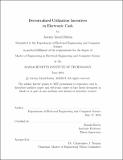| dc.contributor.advisor | Ronald Rivest. | en_US |
| dc.contributor.author | Rubin, Jeremy Lloyd | en_US |
| dc.contributor.other | Massachusetts Institute of Technology. Department of Electrical Engineering and Computer Science. | en_US |
| dc.date.accessioned | 2016-12-22T15:16:41Z | |
| dc.date.available | 2016-12-22T15:16:41Z | |
| dc.date.copyright | 2016 | en_US |
| dc.date.issued | 2016 | en_US |
| dc.identifier.uri | http://hdl.handle.net/1721.1/105964 | |
| dc.description | Thesis: M. Eng., Massachusetts Institute of Technology, Department of Electrical Engineering and Computer Science, 2016. | en_US |
| dc.description | This electronic version was submitted by the student author. The certified thesis is available in the Institute Archives and Special Collections. | en_US |
| dc.description | Cataloged from student-submitted PDF version of thesis. | en_US |
| dc.description | Includes bibliographical references (pages 109-113). | en_US |
| dc.description.abstract | Many mechanisms exist in centralized systems that incentivize resource utilization. For example, central governments use inflation for many reasons, but a common justification for inflation in practice is as a means to incentivize resource utilization. Incentives to utilize resource may stimulate economic growth. However, the asymmetry of economic control and potential abuses of power implicit in centralized systems may be undesirable. An electronic cash design may be able to create resource utilization incentives via decentralized mechanisms. Decentralized mechanisms may be economically sustainable without centralized and potentially coercive forces. We propose Hourglass, a novel electronic cash design that provides a decentralized mechanism to encourage utilization via expiration dates. Constructed in this way, decentralized utilization incentives may have less potential for coercive abuses than more centralized methods, but may be similarly effective in their ability to incentivize utilization. We present the Hourglass system at multiple levels of detail: a design overview, a minimal kernel framework, a series of descriptive refinements, and a concrete implementation as a fork of Bitcoin (a popular electronic cash protocol in common use). We also present several potential applications of Hourglass, such as renewable resource markets, spectrum allocation, stock issuance, and currency. | en_US |
| dc.description.statementofresponsibility | by Jeremy Lloyd Rubin. | en_US |
| dc.format.extent | 113 pages | en_US |
| dc.language.iso | eng | en_US |
| dc.publisher | Massachusetts Institute of Technology | en_US |
| dc.rights | M.I.T. theses are protected by copyright. They may be viewed from this source for any purpose, but reproduction or distribution in any format is prohibited without written permission. See provided URL for inquiries about permission. | en_US |
| dc.rights.uri | http://dspace.mit.edu/handle/1721.1/7582 | en_US |
| dc.subject | Electrical Engineering and Computer Science. | en_US |
| dc.title | Decentralized utilization incentives in electronic cash | en_US |
| dc.type | Thesis | en_US |
| dc.description.degree | M. Eng. | en_US |
| dc.contributor.department | Massachusetts Institute of Technology. Department of Electrical Engineering and Computer Science | |
| dc.identifier.oclc | 965551447 | en_US |
